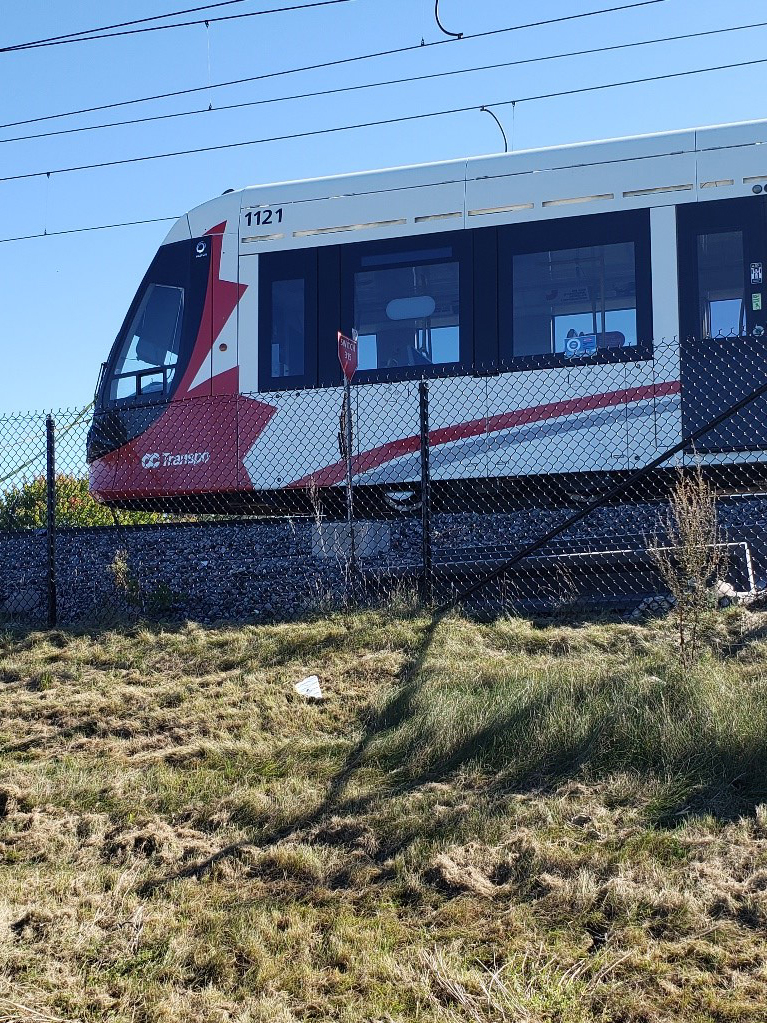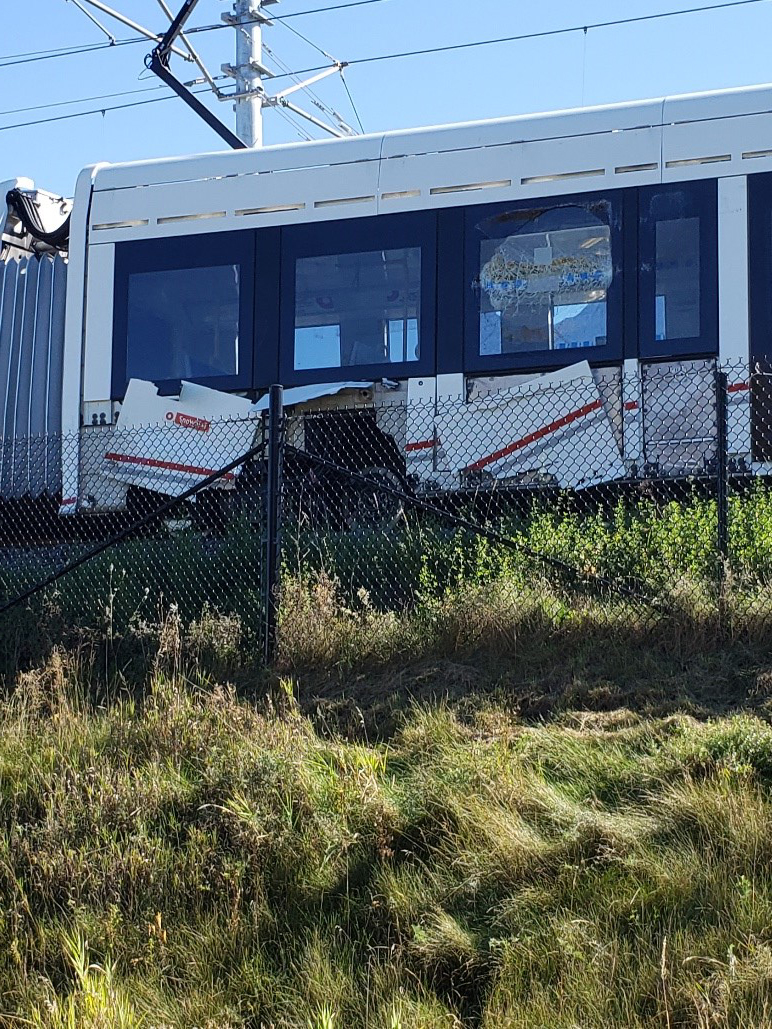Main-track train derailment
Ottawa Light Rail Transit
Confederation Line (1)
Ottawa, Ontario
The occurrence
At approximately 1215 on 19 September 2021, westbound Ottawa Light Rail Transit (OLRT) commuter train 1121-1138 was proceeding on Track 1 when motor-bogie 2 on the trailing light rail vehicle (LRV) 1121 derailed near the middle of the Tremblay station north platform.
The train had stopped within the station, then departed in the derailed condition and continued over the rail bridge that traversed Riverside Drive before striking a signal mast and switch heater that were adjacent to and north of Track 1. Subsequently, the train made an emergency brake application and came to a stop just west of the rail bridge (Figures 1 & 2).
The train, which had 12 passengers and 1 operator on-board at the time, was evacuated once it was safe to do so. There were no injuries. A Transportation Safety Board of Canada (TSB) investigator was deployed on the day of the occurrence. Follow-up site examination was conducted the next day by a team of TSB investigators.
At the time of the accident, the train was being operated from LRV 1138 which was leading as it travelled west. It reportedly approached the east end of Tremblay Station at about 35 km/h and was brought to a controlled stop within the station. After some passengers departed the train, the doors closed and the train began to accelerate slowly then sped up to about 35 km/h. There was no reported unusual train handling nor were any track anomalies observed in advance of the train.
After crossing the rail bridge that traverses Riverside Drive, a train-initiated emergency brake application reportedly occurred and the train came to a stop west of the bridge. Passengers waited about 30 minutes as the rail line was shut down and de-energized. They were then evacuated with assistance from OC Transpo personnel.
TSB assessment
Post-occurrence examination found that the 12 bolts that secured the splined axle stub to the No. 11 wheel hub on motor bogie 2 of LRV 1121 were not adequately torqued when installed during refurbishment. LRV 1121 was then allowed to enter service without a complete set of torque data or Alstom verification that all work was complete. The lack of applied torque led to the failure of all 12 retaining bolts after only about 800 km of service. Failure of the bolts resulted in a disconnection of the drivetrain from wheel position No. 11. Components from thedisconnected drivetrain subsequently dropped from the LRV and contacted the track infrastructure, which ultimately caused the derailment near the middle of the north passenger platform at Tremblay Station.
Work completed
- Full occurrence site examination and documentation.
- The TSB has retained control of the LRV and all related components.
- The TSB has permitted OLRT to download some files of interest and isolate some LRV components identified on the track.
- The TSB observed LRV 1121 as it was re-railed.
- The TSB permitted the train to be moved to the OLRT maintenance and storage facility (MSF) on Belfast Road in Ottawa.
- LRV 1121 was de-coupled from LRV 1138 in preparation for closer examination and removal of LRV 1121 motor-bogie 2.
- Motor bogie 2 and motor bogie 3 from LRV 1121 were torn down and examined by 4 TSB investigators.
- The LRV and components of interest were released to OLRT once examinations were completed.
Conclusion
On 02 November 2021, the TSB issued Rail Safety Advisory letter (RSA) 03-21 on work procedures for OLRT vehicle maintenance. This letter provides more details on the conclusions of the post-occurrence examination activities which included a teardown examination of the motor bogie involved, an examination of the failed components and a detailed review of work records and procedures. Since the parties that can effect change have been advised of the safety deficiencies identified in the RSA, there is no need to conduct further investigation activities at this time.Safety communications
Rail Safety Advisory (RSA) 03-21: Work procedures for Ottawa Light Rail Transit vehicle maintenance
Media materials
Deployment notice
TSB deploys team of investigators to Ottawa, Ontario following occurrence involving a light-rail train (O-Train)
Gatineau, Quebec, 9 August 2021 — The Transportation Safety Board of Canada (TSB) has deployed a team of investigators to OC Transpo Tunney’s Pasture station in Ottawa following the report of an occurrence involving an O-Train. The TSB will gather information and assess the occurrence
Investigation information
Download high-resolution photos from the TSB Flickr page.
Class of investigation
This is a class 5 investigation. Class 5 investigations are limited to collecting data, which are then stored in the modal database. If TSB investigators deployed to the occurrence site, a short description of the occurrence is posted to the TSB website once the investigation has been completed. These investigations are generally completed within 90 days. For more information, see the Policy on Occurrence Classification.
TSB investigation process
There are 3 phases to a TSB investigation
- Field phase: a team of investigators examines the occurrence site and wreckage, interviews witnesses and collects pertinent information.
- Examination and analysis phase: the TSB reviews pertinent records, tests components of the wreckage in the lab, determines the sequence of events and identifies safety deficiencies. When safety deficiencies are suspected or confirmed, the TSB advises the appropriate authority without waiting until publication of the final report.
- Report phase: a confidential draft report is approved by the Board and sent to persons and corporations who are directly concerned by the report. They then have the opportunity to dispute or correct information they believe to be incorrect. The Board considers all representations before approving the final report, which is subsequently released to the public.
For more information, see our Investigation process page.
The TSB is an independent agency that investigates air, marine, pipeline, and rail transportation occurrences. Its sole aim is the advancement of transportation safety. It is not the function of the Board to assign fault or determine civil or criminal liability.

